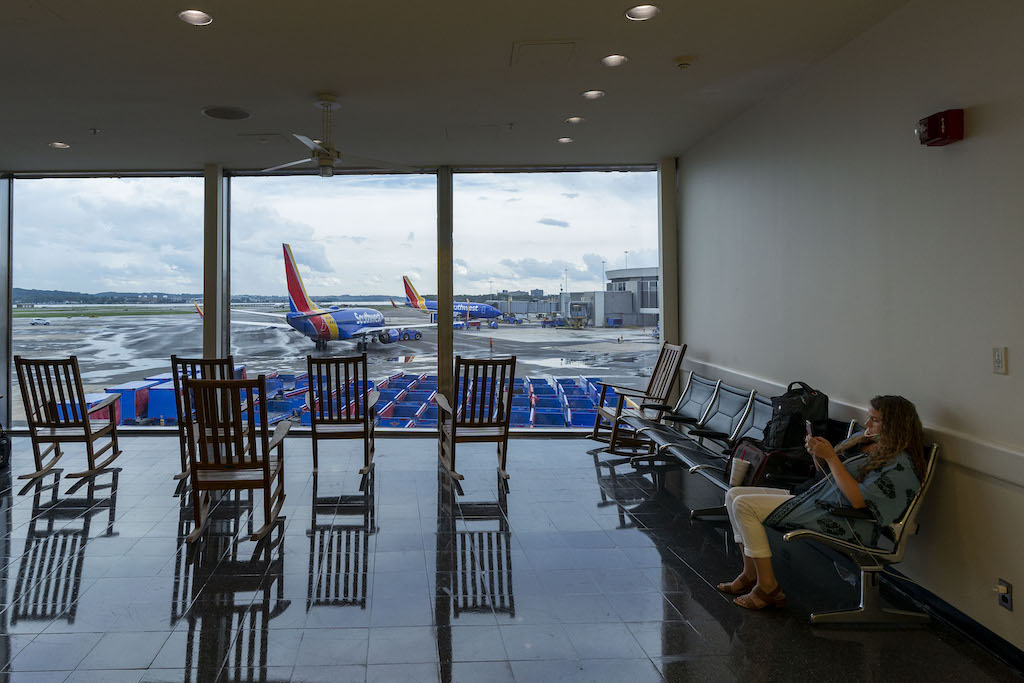Southwest Slows Pandemic Recovery Amid Operational and Staffing Issues

Photo Credit: A traveler relaxes in a viewing area at Terminal A at Reagan National Airport in Washington, D.C. on August 24, 2020. IMF Photo/Cory Hancock Flickr / IMF Photo/Cory Hancock
Southwest Airlines is backing off plans for a quick recovery following a series of operational challenges that culminated in a meltdown that saw nearly 2,000 flights cancelled earlier this month.
The Dallas-based carrier has cut fourth-quarter capacity by 3 points to down roughly 8 percent versus 2019, and executives expect these reductions to continue well into 2022 as the airline focuses on operational integrity and staffing issues. The slowest to return will be markets historically strong with business travelers that saw their deep, multi-flight schedules pruned dramatically as Southwest pivoted to offering more leisure-oriented breadth over depth during the Covid-19 crisis. Headline capacity will return to 2019 levels next year but that depth — and possibly the return of lucrative corporate road warriors — that will take longer.
“2022 will be another transition year in the pandemic recovery," said incoming Southwest CEO Bob Jordan during the airline's third-quarter earnings call on Thursday. "The restoration of the network is a top priority in '22 and '23, but it will take time and it will be largely dependent on the pace of recovery of business travel and our ability to staff.”
Business demand at Southwest was down roughly 73 percent compared with two years ago at the end of September, said Chief Commercial Officer Andrew Watterson. This was a drop from down roughly 60 percent in July and August, and where the carrier hopes to end the year at. For comparison, American Airlines and Delta Air Lines both said business demand was at roughly half of 2019 levels — or nearly 20 points above Southwest — in September. And Alaska Airlines, American and United Airlines all plan to be back to or nearly to 2019 levels next year.
Southwest's lagging business recovery is not entirely surprising — nor necessarily a point of concern. The airline has long been more reliant on leisure travelers than American, Delta and United, and during the crisis pivoted even more to this segment by adding cities like Palm Springs, Calif., and Steamboat Springs, Colo., to its map and greatly expanding capacity to Hawaii. And, as Watterson pointed out Thursday, many of the flights that road warriors want are not back yet and will take more than a year to restore. That timeline is dependent on staffing but also the availability of aircraft; Southwest shifted 92 aircraft to those new destinations and routes requiring it to take delivery of new planes to backfill the flights it cut.
The airline plans to take delivery of at least 72 737 Maxes in 2022, and has options for another 42 deliveries, said Chief Financial Officer Tammy Romo. Southwest has firm orders for 250 737-7s and 149 737-8s, after exercising 16 737-7 options during the third quarter.
Southwest's operational reliability is another major hangup to its recovery. Executives spent much of the third-quarter call explaining and taking responsibility for the delays and cancellations that occurred through the summer and culminated in the meltdown earlier in October.
Gary Kelly, Southwest's outgoing CEO — who cedes the reins to Jordan in February — said he thought that when the carrier recalled the roughly 15,000 employees who took voluntary leaves that they would come back immediately. That, however, was not the case and, coupled with a tight job market, left the airline understaffed and underprepared for the pressures of summer demand.
"For a long time, we had nothing to do. And then all of a sudden, wham, we had to pick up the pace ... and it's just been messy," said Kelly. He added that he "pushed a little too hard" in terms of third quarter flying.
U.S. Department of Transportation data shows just how these disruptions were for Southwest. After posting 81 percent or better on-time flight arrivals for the first five months of 2021, the metric fell to just 62.4 percent in June and 67.9 percent in July, the DOT's latest data show.
For the third quarter, only 71.7 percent of Southwest flights arrived on time, said Operations Chief Michael Van de Ven on Thursday. The airline aims to recover to 80 percent or better on-time arrivals in the fourth quarter.
All of these issues have cost Southwest. Where it once was forecasting profits through the end of the year, it now sees losses. The Delta variant that hit travel demand in August and September cost it roughly $300 million in the third quarter, and is forecast to cost another $100 million in the fourth quarter. In addition, the Indigenous Peoples' Day weekend meltdown hit revenues by roughly another $75 million. These headwinds come as Southwest faces cost pressures, including staffing, airports and fuel.
In the fourth quarter, Southwest expects revenues to decrease 15-25 percent compared to 2019. Fuel expenses are forecast to increase at least 10 percent to an average of $2.25-2.30 per gallon over the same period. And Romo said the airline anticipates at least 4-5 percentage points of unit cost increases above inflation.
Southwest posted a net loss of $135 million excluding special items, which include federal Covid-19 relief, in the third quarter. With said items, the airline had a net profit of $446 million. Revenues decreased 17 percent to $4.7 billion and expenses 18 percent to $3.9 billion year-over-two-years. Passenger traffic was down 5 percent on a 1.6 percent cut in capacity compared to 2019. However, passenger unit revenues — an indicator of airfares — were down a notable 31 percent during the period.
